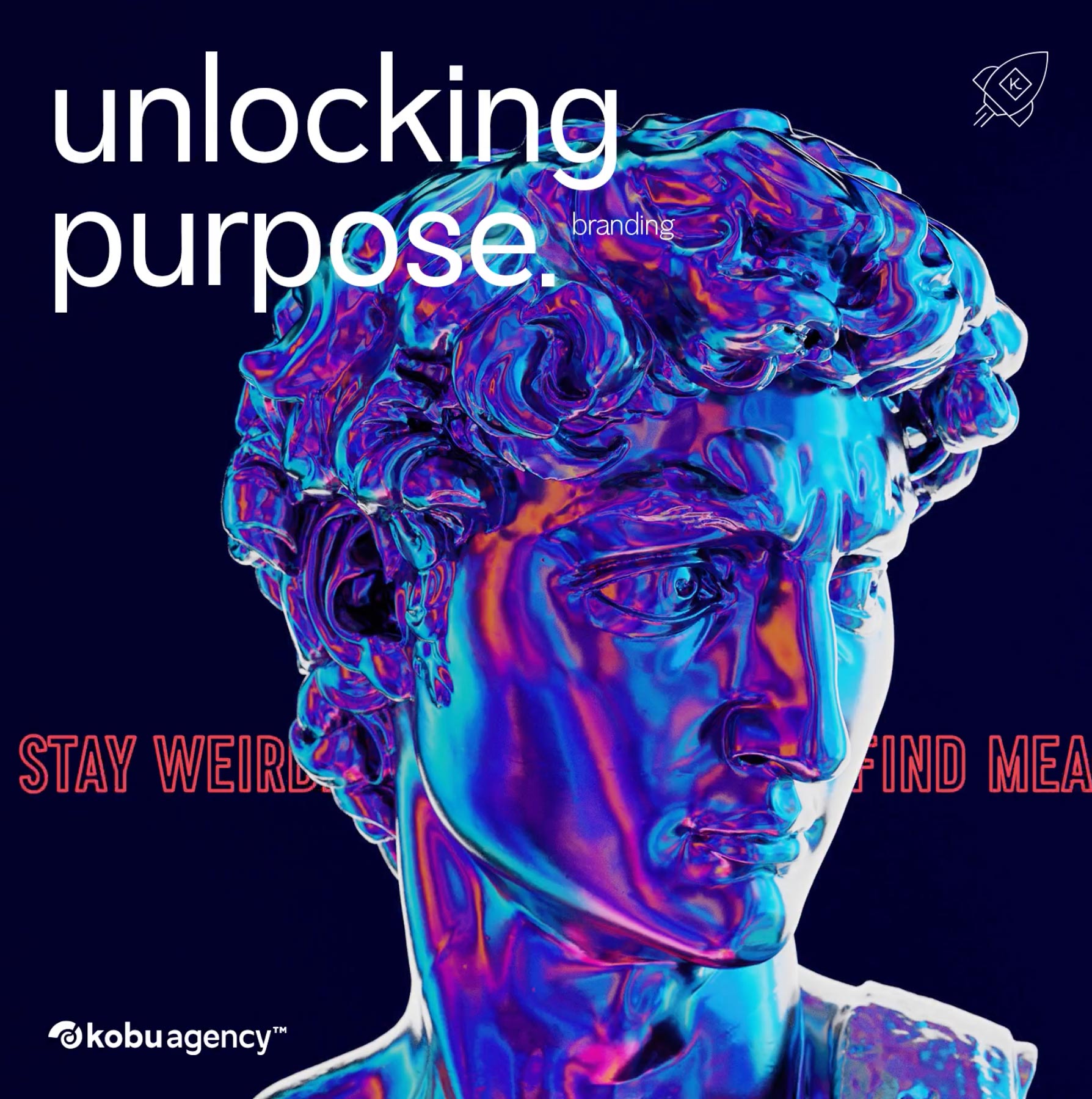Humanity is known for its craving for purpose. From the most mundane aspects of everyday life to the big open questions of Homo sapiens, we all ask ourselves at some point: what’s the purpose of it all? Over centuries, this question has been tackled by religious leaders, philosophers, poets and artists, and in the world of everything digital, the ephemeral aspect of our interactions seems to have brought even more attention to the question – just add “search for purpose” on Amazon and delight on the number of guides and self-help books that pop up. As the cultural milieu evolved, brands also embraced the opportunity to grow stronger relationships with their communities by trying to fill this need. But should they?
Not every brand needs a purpose.

My cup of coffee
Like many of you reading this, a cup of coffee early in the morning brings purpose to my day. As the caffeíne enters my bloodstream, the day becomes brighter, the flow of thoughts more focused, and my brain rejoices in fulfilment.
The everyday morning ritual is highly structured. Before heading to the agency to kickstart another day at work, I stop by a coffee shop, greet the employee with good morning and ask for an expresso at the counter. Short, no sugar. A quick sip takes care of the business; I pay and leave. The experience lasts no longer than 5 minutes on a good day, more than enough to raise an energetic smile through the morning. This ritual has been in place for almost two decades now. The coffee shop may differ during holidays or travelling, or simply because I woke up in a different mood. But there’s an aspect that must remain constant for the experience to fulfil its promise: the coffee brand. I’ve been having the same coffee from this renowned brand since I can remember, so unexpected changes to it can accidentally ruin the whole “awakening” experience. Over the years, the build-up of experience with this brand shaped my taste buds, biasing me towards its preference. It is ingrained into my daily rituals, building expectations. And I’m ok with that – it provides comfort. Interestingly, the company cleverly synthesised this into the brand’s “Coffee for your life” tagline. It definitely feels like it.
Besides being one of the most renowned coffee brands in Portugal, its founder is well cherished among the community. The company has shown commitment to sustainability and environmentally friendly practices, and it has been considered one of the best places to work in the country [1]. Of course, all these aspects weigh in on my unconscious decision to proudly integrate this company’s products into my daily rituals.
It’s curious to notice that, even if I interact with both these brands (the coffee brand and the coffee shop) simultaneously, my relationship with the coffee shop brand is more pragmatic, transactional, and less emotional. I’m in a committed monogamous relationship with a coffee brand while I’m up for “one night stands” with coffee shop brands. And that is also ok: we all have different degrees of interaction with brands and businesses.
Despite being just an anecdotal example of my personal experience, the difference I laid out helps shed some light on the fact that not every brand needs to deliver purpose (the coffee shop), but for some, it really matters (the coffee brand).
A true brand purpose doesn’t boost profit;
Mark Ritson
it sacrifices it.
Purpose-driven brands: failed expectations and the rise of alternative models
In an op-ed in Advertising Week from 2019 [2], Mark Ritson explores how brands often commit to being purpose-driven without actually undertaking the necessary structural changes it entails at the business level. Ultimately, the objective of profit usually gets in the way because a grand purpose is not aligned with maximising shareholder value. A likely familiar example of this is greenwashing [3], or the act of driving customers to perceive a brand as sustainable or environmental-friendly when that is not the case. One needs just to head to the examples section of Wikipedia’s page for the term greenwashing to understand the transversal implementation of these practices.
In an era where information flows almost immediately, and new generations are increasingly alert to company behaviours, these misalignments can come at significant costs for companies. It is thus pertinent that we understand what being “purpose-driven” actually means and how can that be translated into business models, products, operations, branding and marketing strategies. Or even if it makes sense to undertake that transition.
Chris Martin proposes a Generalised Model of Purpose in a 2021 article from Forbes [4] to work on this conundrum. In his own words, “a simple but radical idea: replacing the existing model of brand purpose that is driven by an individual company’s mission centred around business activity (shareholder value) with a generally defined goal of equitably improving the well-being of all stakeholders”. Seems like a radical idea? Maybe. Definitely a daunting task, but not an impossible one. In order to kick off this process, one must understand that the core of this change lies in replacing the function to which we optimise business for something that proxies the “well-being of all stakeholders”.
The last statement should not be (mis)understood as an appeal to sacrifice profit growth. Profit growth is necessary to undertake the quest to build a purpose-driven brand. It simply means that profit growth must be considered among other metrics that must translate the brand’s purpose. Let’s delve into that in the next section.

Unlocking brand purpose
Leading a digital branding agency, there’s nothing more challenging and exciting for my team and me than to build a consistent brand that upholds its principles and engages meaningfully with customers and communities and see it evolve and adapt as time goes by. It is clear to us that an authentic brand purpose shouldn’t be just another messaging cloak for a brand strategy. The business itself and its people – shareholders, decision-makers, employees, customers, and the community – will naturally orbit around the brand’s purpose once it is well structured.
In a series of reports [5][6], Victoria Hurth and Aris Vrettos explore how “Business-as-Usual” (BAU) companies and their adjusted counterparts have partially failed to deliver in building a sustainable and equitable future. They additionally lay the approaches, steps and principles behind building a purpose-driven business; in their own words: “A mature purpose-driven company will be increasingly displaying its purpose in all aspects of organisational culture – its cultural hardware such as systems, processes, structures, materials, investments, artefacts and all strategic decisions, and its cultural software, such as assumptions, practices and behaviours. For most companies, a legacy of business-as-usual thinking means the existing culture will have been optimised for delivering profit maximisation. For the hardware and software, and organisation to be optimised for delivering well-being outcomes instead, a transformation of the organisational system is required. […] Companies with a robust and genuine intent to deliver long-term well-being cannot and should not wait until they get everything right. They need to, and can, be transparent about their goals and carve a robust plan for the transition to build momentum with employees and stakeholders to deliver their shared purpose.”
Over the years, we at KOBU Agency have been working on the branding efforts of several businesses that we can clearly identify as purpose-driven (head to our Case Studies to view some examples). These seem to share some interesting patterns that can be enumerated as follows:
- The people behind these brands are invested in positively impacting the world.
- The businesses supporting these brands are built around that purpose, and their product and/or services are tools to enact the change.
- There is an internal commitment to that purpose from shareholders, key decision-makers and the team, coupled with the flexibility to adapt to external circumstances.
- The people behind the business pursue an authentic engagement with the community of the brand.
Delving deeper into how these businesses evolved, driven by their purpose, the first and foremost step is for them to clearly define what is meant by the well-being of every stakeholder. For most of these companies, this list will most likely include founders and/or shareholders, key decision-makers, customers, employees, suppliers, and the communities they impact (local or global). The next crucial step is to have this purpose translated into something that grasps the aspirations of the several parties and allows them to act around that. Given the diversity of the agents involved, very seldom will this be encapsulated in something as simple as a tagline – as inspirational as it may be. It will vary from company to company but probably include brand assets such as manifestos, mission and vision statements, brand messages, and progress and transparency reports.
As mentioned before, to support the implementation of a purpose-driven brand, we also need to rethink organisations from the inside. The following actions should be taken into account.
Redefine measures of success.
Additional metrics must be put in place for us to measure how the purpose is being accomplished. How is value being generated and measured for the different parties involved? How do we measure the impact of our actions and potential externalities?
Instil purpose from the get-go.
The purpose should guide every business decision: from what new products or services we deliver to how operations are structured, how suppliers are chosen, how human resources are organised, etc. It goes way beyond brand communication.
Foster honesty and communicate transparently.
In day-to-day business operations, struggles will inevitably arise. Commitment to being a purpose-driven brand is as essential as remaining humble and honest about failures, communicating them openly and transparently, both internally and with the brand’s community.
Provide, share, endeavour
While contributing to building some purpose-driven brands, we’ve noticed patterns that have now been translated into a framework that guides us towards unlocking brand purpose.
This toolkit can be synthesised into three action vectors: provide, share, and endeavour.
Provide
- Improve the world with services or products
- Uphold a level of care
- Respect the brand’s core values
Share
- Spread the word
- Educate and entertain
- Build knowledge
- Balance facts and emotion
Endeavour
- Engage meaningfully with communities
- Update perspectives
- Break stigmas
- Empower people
This allows us to have a holistic approach to our clients’ businesses and identify opportunities to work with them in rethinking their positioning and moving them towards a purpose-driven brand.
It is ok to not want to “save the world”
I must confess that I have an appetite to work with businesses that look for a long-term purpose and are willing to put in the work to create something that has a tangible impact on the world. It’s an incredible challenge and a gratifying process as we can witness the effect some companies have on communities around the globe.
But as my discursion at the beginning of this article pointed out, the subjective value of purpose makes the decision to become a purpose-driven business and brand one that should not be taken lightly. It is ok to not want to “save the world”. We can only do what we can do, and that is ok. Not every brand needs a greater than life purpose. But for some, it really matters.
Transparency disclaimer
Article written by Nuno Tenazinha.
References
- Delta Cafés lidera Top 20 das empresas mais atrativas para trabalhar
- Mark Ritson, A true brand purpose doesn't boost profit, it sacrifices it
- Greenwashing: 10 recent stand-out examples
- Chris Martin, The Future Of The Purpose-Driven Brand
- Hurth, V., and Vrettos A. (2021). Unleashing the sustainable business: how purposeful organisations can break free of business-as-usual. Cambridge, UK: University of Cambridge Institute for Sustainability Leadership.
- Hurth, V., and Vrettos A. (2021). Unleashing the sustainable business: how purpose transforms an organisation. Cambridge, UK: University of Cambridge Institute for Sustainability Leadership.
How do you feel about this article?







